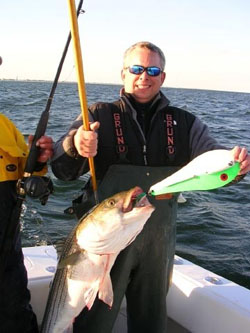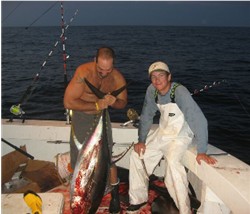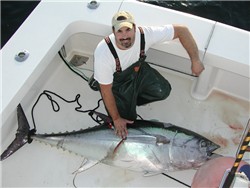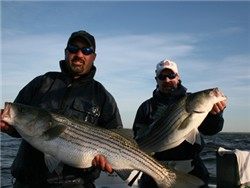Latest News & Info
- Details
- Written by: Capt. Brian
Give 'Em What They Want
On the hunt for Sandy Hook's big striped bass.
By Mark Marquez II
Give them what they want.
Those are some of fishing’s watchwords.
If fish are feeding on a bait, fish that bait. Or if they’re hitting a certain lure, use that lure.
Or if a certain type of fish, like a big one, is caught a certain way, fish that way.
Don’t mess around.
Most striped bass anglers around the Sandy Hook area dunk a large variety of baits and lures in fall.
From boats they soak clams, sandworms or bunker chunks; liveline eels or bunker; work metal jigs; or troll bunker spoons or other lures.
They do it all, unlike striper fishing at other places in New Jersey in autumn. Barnegat Inlet anglers mostly fish clams, and Delaware Bay anglers usually chunk bunker, for example.
But serious striper anglers from Sandy Hook are prepared for all options, usually depending on what’s working best during a given stretch of days.
Still, how do you narrow the options?
That depends on what you want to catch.
Large striped bass are what Capt. Brian Rice from Jersey Devil Charters from the Highlands wants to clobber on his charters.
He does keep his options open, and, for example, if livelining eels at the Sandy Hook Rips is best by far during a period, his anglers will certainly jump on the bite.
Or if clamming at Romer Shoal is exceptional, that’s the drill that day. And so on.
But for trophy linesiders, Jersey Devil most of the time will sail prepared for several types of fishing: bunker chunking, livelining bunker and trolling.
Those three options consistently catch the biggest stripers for Jersey Devil in fall.
Eeling will attract big bass, but eeling turns on and off, and although some anglers love eeling, probably connect often, it’s not the most reliable.
Clamming, worming and jigging usually catch large numbers of linesiders but smaller ones.
Nothing wrong with that, but just depends on an angler’s priorities. Big bait, big fish. Look at the size of that lure, a Tournament Grade Tackle Horse Bunker Spoon. Large linesiders often inhale bunker chunks or attack livelined bunker or trolled bunker spoons or other lures.
 |
| Big bait, big fish. Look at the size of that lure, a Tournament Grade Tackle Horse Bunker Spoon. |
Give them what they want.
A day on the waters for Brian begins with castnetting bunker for the charter who will arrive later that morning.
He avoids buying bunker or storing his own in a pen, because the freshest bunker that can be fished with the most natural presentation can be key for trophy striped bass, the wariest of linesiders.
Penned bunker can become red around the nose and gills and get some of the slime knocked off of them.
So Brian catches 100 of the baitfish to keep on the boat for the trip that day.
Most are placed in the vessel’s two livewells for liveline fishing, and some are stored dead in a cool place on the boat for cutting them to fish as chunks.
Brian tries to avoid putting the menhaden for chunking on ice, because the freshwater is an unnatural element that can damage the bait.
On the charter, if bunker are schooling the area, he’ll usually set up either on a drift or on anchor and fish a combo of live and chunked bunker, and if one works best, all lines will be switched to that bait.
If no bunker are around, he’ll troll to cover ground to locate bass.
First, about the bait fishing. When fishing bait, the boat will often be anchored if a specific structure or hole that’s likely to hold fish is the target. If a broader area is meant to be fished, drifting gets the nod.
For chunking, Brian will cut the bunker on an angle from behind the head to the vent on the bottom of the fish, keeping the entrails attached.
An 8/0 Owner SSW circle hook is stuck through the bottom jaw and out through the top jaw.
That helps keep the bait from spinning in the current and prevents other unnatural presentations, like flared gills if the head was hooked from the back.
A 2-1/2-foot, 50-pound Gamma fluorocarbon leader is snelled to the hook, and the other end is attached to a 130-pound Owner swivel, and the main line is attached to the swivel.
A fish-finder or sinker slide rig is used, and the weight is either attached to the snap on the slide or to a length of light line attached to the slide.
If the fish are found on the bottom, the snap is used. If they’re feeding farther up in the water column, an appropriate length of line is used to attach the weight. Brian will set out various options and see what works, and then stick with that.
Big stripers will often hug the bottom, but not always, and he’s caught them from bottom to top.
Live bunker are fished on the same rig but maybe with a bigger hook or 10/0, depending on the size of the bait.
Livies are hooked through the nose, through the lips or behind the dorsal fin. If the boat is drifted, the bait is hooked through the nose or the lips, because the bunker gets dragged and should be fished as naturally as possible. Don’t drag it backwards.
If the boat is anchored, hooking the baitfish behind the dorsal can help make the bunker swim away from the boat.
If both the chunking and livelining rods can be fished in the rod holders, that’s what Brian does. That allows a striper to hook itself with no errors from the angler. We tend to overcomplicate.
But if currents on anchor or the drifting boat prevents the lines in rod holders to lie clear of each other, anglers will hold some of the rods to help.
While trolling, Jersey Devil in fall usually drags two Tournament Grade Tackle bunker spoons, one on the port side and the other on the starboard, and a Stretch plug down the middle.
The Stretch plug tracks well on a straight line in the middle.
The fish are often feeding on bunker, so imitate the bunker with the spoons. But if more big bass start to smack the Stretch, Brian might switch to all Stretch lures.
Tournament Grade Tackle makes a large, 14-inch Horse Bunker Spoon that can be deadly on lunker stripers. Big fish eat big bait.
Catch those two points: The fish are often eating bunker, and big bass will eat the biggest bunker. Give them what they want.
Brian trolls with custom-made, soft-action, 10-foot rods that help impart an extra lively, natural presentation.
Many variables come into play for all these methods of fishing, and these are basic ways that Brian catches large striped bass. The next advice is to get out there and put in the time, start developing techniques that suit you, enabling you to land big bass consistently. Anglers can always book a charter specializing in the fishing, and pay careful attention to details, too.
Figure out what big stripers want.
Then give it to them!
- Details
- Written by: Capt. Brian
Tuna Chunking
Well, the offshore tuna chunking season is beginning. I’ll cover the basics.
My trips start days in advance, when I and my crew begin studying temp charts and gathering as much data as possible from other captains as to where to set off for the trip.
I use a couple of free, online chart services from Rutgers University and Hot Spots and also order a chart from Roffs to locate the best water that should be holding fish.
But as I said before we try to get recent reports from boats that sailed and had good catches.
Preparation
We start by getting the freshest baits possible. Make sure you look at the eyes and fins on the butterfish and sardines. The eyes should be clear, and the fins shouldn’t be all withered or beat up.
We typically get three to five flats of butterfish and one or two flats of sardines and buy a bunch of packages of frozen squid from the supermarket.
All the bait is cut or chunked at the dock before the trip, and all of it is mixed together in garbage bags and stored on ice below deck.
When cutting the chunks we’re on the lookout for large, fresh sardines and butterfish. These are put on ice in zip-lock bags and used as hook baits.
Rigging Up
We use Shimano Tallus 60- to 80-pound-class rods mated to Shimano 50-wide reels spooled with 80-pound Momoi monofilament line. We also use Tallus 20- to 40-pound-class rods with Shimano Tyrnos 2-speed 30 reels with 40-pound mono.
We use 5/0 Gamakatsu 4X octopus circle hooks tied to Gamma 40-, 50-, 60- and 80-pound fluorocarbon leaders attached to the main line with Spro 130-pound swivels.
Three rods are rigged with black fish-finder sinker slides with snaps on them, so we can use whatever weight we need to get the baits down to where we want.
All of our knots are Palomars because they have approximately 100-percent knot strength, and we can tie them easily in the dark.
 |
Twelve to eighteen rigs of each size leader are made up ahead of time, so we aren’t wasting time retying rigs from scratch when we get into fish.
Make sure your harnesses and belts are adjusted and ready to go. Also make sure your gaffs are sharp and ready to go.
Setting Up
We start throwing chunks as soon as we arrive. A handful is thrown out to see what type of drift there is or which way the chunks will go as we set our anchor or adjust our position for the drift.
We’d rather drift if we can stay with the water or the marked fish and bait.
Once you’re set up, make sure everyone has a job to do. One angler will throw chunks consistently: three to five chunks every 50 to 70 seconds. If the chunker has to go away from the bucket, make sure someone takes over. This is very important, because you never want to break the slick.
We keep a chum chucker on the boat so we don’t have to worry about hand-ladling the chunks and just have to make sure that the hopper is full at all times.
Start off with 60-pound leaders, and go to 40-pound if the fish are line shy. If the fish are big and hitting hard, go up to 80-pound leaders.
We cut a butterfish in half and run the hook through the mouth and out the gill. Then the hook is inserted back into the bait under the pectoral fins, with just the point protruding. Cut off the fins so the bait doesn’t spin. The sardines can be hooked in a similar fashion but are better off hooked through the eyes. To fish the baits, we place them the following ways: one above the thermocline around 80 or 90 feet down, and one just below it, usually 100 to 120 feet down, and one about 50 feet. We also use one as a “floater” that is hand-lined out without weight, back in the slick 100 feet or more, and then reeled in and repeated.
 |
Once the squid arrive around the boat we’ll do our best to either scoop them up with a net or jig them with squid jigs if they’re deep. We’ll take the live squid, hook them in the mantle and drop them right back down, staggered the same way as the butterfish and sardines.
Make sure there are more rods rigged and ready to go. When the bite is on it may last only 30 minutes or 3 to 4 hours. In any event you want to make sure you’re spending the most amount of time with baits in the water, as opposed to re-rigging rods and tying rigs when the bite is hot. These are the basics. A good way to learn, and to hook up, is to fish with someone who’s experienced or a pro. Good luck!
- Details
- Written by: Capt. Brian
Raritan Bay Bunker Chunking
In early spring, small, resident striped bass are the first stripers to bite in Raritan Bay and in the Sandy Hook area. Anglers mostly dunk clams or sandworms to hook these young fish. But by the end of April or early May, menhaden start schooling the waters, and trophy-sized, migrating stripers soon follow, and feed on the bunker. Time to catch a wall hanger, and also time to switch baits. Bunker chunking, or fishing large pieces of fresh bunker, is the name of the game.
Here’s an outline of every aspect of bunker chunking for striped bass, from getting the bait to locating the stripers to catching them. By offering this outline, I’ll end up explaining small details that in the past have given me a slight advantage over the “other guys.”
Getting the Bunker Baits
There are three basic methods.
- Buy it fresh from a local tackle shop
- Snag it with weighted treble hooks
- Castnet it – the preferred method
Once you have your bait, take some steps to keep it in prime condition. We keep 50 or 60 alive and then ice down another 50 or 60 in saltwater ice.
Finding the Right Spot
Now that we have our bait, let’s find our spot. We look for any kind of structure, such as rocks, mussel beds and drop offs, areas that typically hold fish, and then we anchor where the fish are in relation to the structure. We start our chunking by throwing small pieces of bunker up tide. We never throw heads over, because heads are the hook bait of choice for us when chunking for big fish.
Be sure to cut the bunker on an angle, from the top and back of the head to the vent on the bottom of the fish, making sure to keep the entrails inside. We use 8/0 Gamakatsu Octopus circle hooks, sticking the point up through the bottom jaw and out through the top jaw. This helps keep the bait from spinning when the current is strong. It also prevents other unnatural presentations, like flared gills if the head were hooked from the back or from the side that ’s cut. We remove the tail from the other cut, and hook that bait in front of the dorsal fin, sticking the point through the meat side and up through the skin.
Rigging Up:
We use 15 to 20 inches of 50-pound Gamma fluorocarbon leader snelled to the 8/0 Gamakatsu. If the current is strong, we use an even shorter leader to help keep the bait on the bottom, so it doesn’t spin. Big fish are on the bottom, so don’t hesitate to lay the chunk there. The leader is attached to a Spro 130-pound swivel. We use a sinker-slide on the main line, either 20-pound mono or 50-pound braid. We clip our weight to the slide using a snap.
 |
| A couple of stripers bunker chunked with Jersey Devil Charters. |
Rods/Reels
We use Shimano Calcutta 700’s and/or Torium 16's on 7-foot, medium-action, Tallus Bluewater conventional rods. We set out rods covering the whole area behind the boat: two short, two moderate range and two way back and off to each side of the boat. Since we are using circle hooks we leave the rods on the holders until they’re bent over, indicating that the fish is hooked.
Remember, we do chunk the bay, but the chunks are small and thrown up current and put in with chum on the bottom to get the scent out. If the blues start to attack, stop chunking altogether.
These are the basics of how to catch trophy stripers by chunking. There are many variables that come into play, so the best advice that I can give is to get out there and put in the time. Or you can always charter a boat specializing in chunking and pay close attention to details. Do not be apprehensive about trying new methods, and start developing a technique that fits you, and allows you consistently to catch fish.
